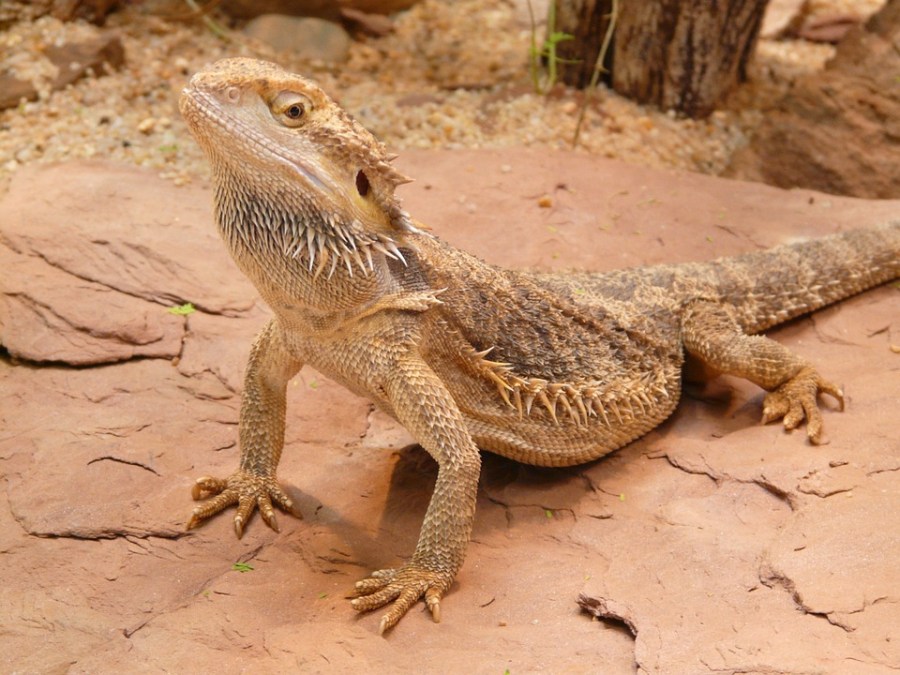How to Draw a Bearded Dragon

While some children prefer cute rabbits or puppies as pets, there are many that are fascinated with reptiles. Often lizards, snakes and turtles can be found in terrariums, but don't be surprised to see Pogona's, more commonly known as Bearded Dragons, roaming about in children's bedrooms. These creatures will typically grow to be between 16-24 inches long and make for ideal pets if taken care of properly. Here are a few tips to help you decide if a pet bearded dragon is the right fit for you and what is required of you if you do decide to get one.
Personality
What makes these reptiles ideal pets is not only their relatively low maintenance but also their gentle and even-tempered personality. Unlike lizards, they sleep at night and are awake when you are. They also enjoy being handled and stroked by their owners and will eventually be capable of recognizing their owners' voice and touch. Don't be afraid to take them out of the aquarium and let them roam around or have them hang out in your hands while you stroke them. Just make sure to wash your hands thoroughly afterward.
Whenever you are either watching them in their habitat or while they are chilling on your bed, it can be fascinating to observe their behavior, especially if you have two or more. One of their common tendencies is to engage in arm waving. This is where they stand on their three legs and raise their fourth as a way to notify a fellow bearded dragon that they are aware of their presence or as a sign of submission. Another behavioral pattern is when they bob their head up and down. This is seen more commonly in males as a way to show their dominance or submission, depending on how quick the bob is. The faster the bob, the more threatening and dominant they are. But don't be worried about them attacking you in any way, even if they are feeling threatened. Often they tend to freeze, puff their throat and/or change color if they are in danger. Apparently, there was a small amount of venom found in these reptiles, but it has no effect on humans and seems to be a sign of their evolution over time.
Habitat
When taken as pets, they should be kept in an aquarium or terrarium that has a screened top and is at least 36″x12″x18″. These reptiles are native to Australia and were initially introduced to the United States in the 1990's. Their new homes should resemble their natural habitat as closely as possible which consists of hanging out on branches, rocks and logs that they can hide, climb and bask on.
Because they are used to the hot, arid Australian environment, make sure to include UV lights that can represent the sun during the day and allow the bearded dragons to receive their Vitamin D which helps their skin absorb calcium and phosphorus more efficiently from their food. Some pet owners will also include a heating pad under the tank and décor, such as artificial plants, to fit the landscape.
Food
Bearded dragons are omnivorous creatures, meaning they prefer to eat insects and plants. They should be fed a daily mix of vegetables, such as beans, carrots and peas, along with fresh vegetables like collard and dandelion greens, kale, mustard and shredded raw carrots. Make sure the greens though are finely chopped up. The smaller the dragon is, the more finely chopped the greens should be. Whatever you do, don't feed them spinach or broccoli as overconsuming either of these can be fatal. On top of the vegetables, add in crickets, mealworms or gut-loaded super worms into the diet every other day. Consider also providing dietary supplements, specifically Calcium and Vitamin D3 to help keep their bones strong and healthy.
Cleaning
Because they are consuming a large amount of food throughout the day, this also means there is plenty for you to clean up daily. While cleaning their habitat, focus on cleaning their water and food bowls. Using an aquarium fish net can be helpful when scooping out their waste. Creating a healthy and happy environment will help these reptiles live a full lifespan which can range from 10-13 years if taken care of properly.
Source: https://www.life123.com/home-garden/how-to-care-for-your-pet-bearded-dragon?utm_content=params%3Ao%3D740009%26ad%3DdirN%26qo%3DserpIndex
0 Response to "How to Draw a Bearded Dragon"
Post a Comment